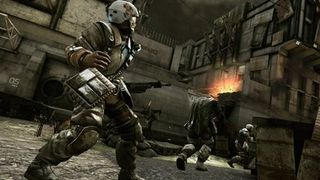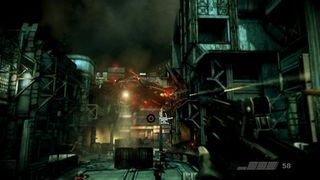Speaking of those characters, you’ll be accompanied at nearly all times by at least one of your three squadmates: there’s Rico (the barking thug), Natko (the grizzled asshole) and Garza (the smart one), who you’ll be spending the most time with. All three are generally competent, tough and useful in a fight, although Sev seems to be the only one with skills other than shooting a gun; you’re the only one who revives downed allies, sets explosives, switches weapons, drives vehicles or turns valve-like switches to open massive doors. Skilled or no, your squadmates are also really chatty, and their f-bomb-laced banter is a big part of what strings the story along.

They’re so integral to the story and game, in fact, that it’s surprising that co-op playwasn’t includedas an option. To ignore it when it’s become such a common feature in shooters is one thing, but a game in which you rely on teammates to watch your back, lift you over obstacles and open doors seems tailor-made for charging through with a friend.
But whatever. The action holds up fine without a real buddy along. Killzone 2’s a pretty straightforward shooter, and most of your time will be spent just perforating squads of Helghast as you jog between primary objectives, which usually involve blowing something up or clearing the way for everyone else (both done with near-flawless use of Sixaxis motion controls). Sometimes you’ll even get to commandeer a tank, warship turret or robot exoskeleton, all of which are a lot of fun despite only showing up briefly for short-range runs.

When you’re on foot, sticking to cover plays a big role, and when the action gets thick, you can duck behind any waist-high object and lean out to shoot. In general it works well, but not always; the first-person perspective sometimes makes it difficult to judge how well you’re actually hidden, and it also feels strangely incomplete, because everyone except you is able to blind-fire around cover, while you have to poke your head out to aim.
At their best, the game’s firefights are crowded, pitched set pieces, with Helghast pouring in from every angle and doing their impressive best to duck out of your line of fire and get the drop on you. (At their worst, they’re typical corridor shootouts. But what pretty corridors!) You can only carry one “main” weapon (assault rifle, shotgun, flamethrower, etc.) into battle at a time, along with a pistol, knife and a handful of grenades. It’s a pain in the ass, but it makes planning ahead and conserving ammo especially important. It’s also easier than you’d think, because as enjoyable as it is, the action can get pretty predictable.

Probably the key flaw in Killzone 2 is how meticulously scripted it is. For example, if a Helghast is programmed to run to a certain location and then start shooting, he usually won’t shoot until he gets there, even if you’ve ambushed him and are filling him with holes. When enemies show up for a big set-piece battle, they’ll tend to show up the same way in the same places every time, enabling you to anticipate and pick them off if you’ve died and started the battle over. Some battles, meanwhile, will only begin or end if you’ve walked to a certain point on the map, triggering a key event. Noticing this stuff can help savvy players get ahead, sure, but it can also ruin any sense of immersion the game might have built up.


